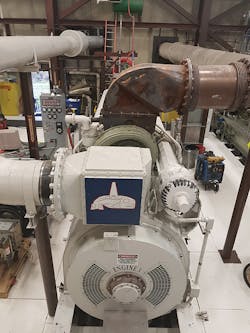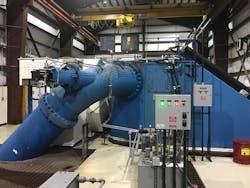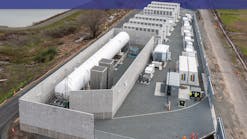Cordova’s Microgrid Integrates Battery Storage with Hydropower
Several remote, off-grid communities in Alaska have adopted energy storage systems as part of their microgrids, as they drive to replace expensive diesel generation with renewable wind and solar power. Now, the small town of Cordova, Alaska, U.S., 150 miles (241 km) southeast of Anchorage, Alaska, is pioneering the integration of a Lithium ion (Li-ion) energy storage system (ESS) into a hydropower microgrid. The aim is to recover lost hydro generation that currently must be spilled during transition periods between hydro-only and combined hydro-diesel generation.
The town has no grid connection, so it relies on a microgrid managed by the Cordova Electric Cooperative Inc. (CEC), which operates under the principles of sustainability, resilience and holistic thinking. For example, CEC delivered its Power Creek hydropower facility with funding from CoBank, rural America’s cooperative bank, to ensure energy security and cost stability for the community. For another project, CEC put all the town’s power lines underground to eliminate risk of outages during the winter months. In the future, it is considering integrating energy storage with electric vehicles.
However, the current focus has been on fine-tuning a new ESS planned for installation early this year to maximize the use of renewable energy and reduce reliance on costly diesel fuel.
Hydropower Microgrid
CEC covers Cordova’s baseload with a 6-MW run-of-river hydro generator at its Power Creek facility, and it also operates a 1.25-MW run-of-river hydro facility at Humpback Creek. The hydro is supplemented when needed by output from the Orca diesel generation plant, where the main control center is located. Two 1-MW diesel gensets are used to support the transition from hydro-only operation. The gensets are powered up during the winter when the rivers freeze and in the summer to support peak loads.
Cordova is located at the mouth of the Copper River, a renowned salmon spawning ground. As a result, the town’s fish-processing industry places highly seasonal electrical loads on the network.
CEC’s hydropower costs are around $0.06/kWh. In contrast, diesel generation costs can range as high as $0.60/kWh, depending on fuel prices. Therefore, whenever possible, CEC prefers to run on hydropower alone and typically meets as much as 78% of its annual demand this way.
In hydro-only mode, operators control the grid frequency by adjusting the angle of fast-acting deflectors at Power Creek. These divert part of the water stream away from the turbines to modulate their power output, thereby maintaining grid stability. This is like the concept of spinning reserve in a conventional grid, and CEC typically deflects around 500 kW of capacity to support sudden load increases. However, with run-of-river hydro being a use-it-or-lose-it resource, deflected water simply flows down the river and the energy is lost.
Seasonal Transitions
As several hundred workers arrive and fish-processing plants ramp up their production during the spring, CEC transitions from hydro-only to a combination of hydro-diesel generation. When the hydro reserve drops below around 500 kW, a 1-MW diesel genset starts. Because the diesel must run at a minimum output of 400 kW, this increases the amount of hydro that must be spilled. The net effect during this transition period is CEC can sometimes waste more than 1 MW of water power while burning expensive diesel fuel at the same time. Depending on load patterns, the changeover can last from a couple of hours to several days.
CEC recognized a grid-scale ESS would enable it to make the most of its renewable energy and control costs while reducing reliance on imported diesel. The coop turned to Saft to develop a Li-ion-based ESS solution rated at 1 MW with 1 MWh of energy storage capacity. A package solution was identified as the preferred option: an ABB power converter and battery container located at the central substation in the CEC grid.
ESS Operating Principle
The ESS will provide what amounts to additional spinning reserve, enabling CEC to open its deflectors fully and avoid spilling hydro generation capacity. Rather than starting up the diesel generators when flow past the deflectors drops below 500 kW, the co-op specified the ESS operating principle to pick up the load to inject and absorb power to maintain grid frequency. CEC’s consultant, Electric Power Systems Inc. worked with Saft to develop a detailed control philosophy and operating setpoints for the various transitions involved with dynamic load excursions.
When the ESS state of charge (SOC) drops below 30%, CEC’s automated dispatch system will start up the genset, which then can operate at its minimum output of 400 kW to supply demand and charge the battery at the same time. If the SOC reaches 70% and the net load remains low, the diesel will shut down and the ESS will discharge, whereas if the net load increases above 400 kW, the diesel will take over frequency management and the ESS will be charged only if there is diesel capacity to spare.
Risk Control Solution
There are multiple benefits of procuring an ESS as part of a package that also integrates power conversion and controllers. CEC can rely on operational and performance guarantees as well as outsource the need for specialist engineering integration and optimization. In addition, the long track record, responsiveness during the tender process and industrial pedigree of Saft and ABB as the suppliers of the major system components gave CEC management confidence that both have the financial and technical resources to deliver the sort of long-term support the coop needs.
Furthermore, both suppliers offered other technical solutions and advantages, such as high-speed grid controls and a modular shippable package that can be preassembled before delivery and installed on a plug-and-play basis. This will help the utility to manage the cost premiums that otherwise can arise for projects in remote communities. Another major benefit is that the solution has been installed on a commercial basis elsewhere in Alaska. It demonstrated that the technology could withstand the tough Alaskan environment.
Total Cost of Ownership
When purchasing an ESS, it is important to choose carefully. Removal, recycling and replacing a full battery set can represent an additional 60% on top of the initial purchase price of a package. In addition, factory warranties and annual maintenance contracts can be costly, especially for remote communities like Cordova.
CEC wanted to deliver optimum value for its community. Its first step was to carry out modeling with the support of Dr. Imre Gyuk, director of energy storage research at the U.S. Department of Energy, who commissioned Sandia National Laboratories and the Alaska Center for Energy and Power at the University of Alaska Fairbanks. This was a starting point to specify the ESS as well as provided a share of the costs to support the integration.
To support the modeling and estimate fuel savings, CEC selected several months of detailed load and hydro data from its multiyear database. Additionally, Saft plans to run detailed simulations based on the new control philosophy to validate the fuel savings and calculate battery aging.
During the modeling process, several important aspects of energy storage and battery technology came to the fore, especially the impact the operating regime can have on battery aging. For example, under the right conditions, the aging of Li-ion batteries can be reduced to a capacity loss of less than 1% per year. This is accompanied by a slight loss in roundtrip efficiency, although the power capability remains almost constant. However, Li-ion batteries can age catastrophically if used aggressively to the point of abuse. Therefore, the choice of operating setpoints is critical for battery life and, consequently, an optimized return on investment.
In addition, energy storage capacity over life is an important factor. Deep cycling causes a more rapid loss of capacity. For example, if an ESS rated at 1 MW and 1 MWh is completely charged and discharged from 100% to 0% SOC, it will deliver perhaps 5000 cycles, equivalent to 5 GWh of total energy delivery. However, if it delivers small charge and discharge cycles of around 5%, the same battery can deliver 1 million cycles, or 30 GWh, over its life.
Therefore, as an ESS for an application grows in size, its lifetime also increases—but so does its purchase cost. As a result, it is important to find the sweet spot that balances the priorities of total cost of ownership. Fortunately for CEC, frequency control operation requires many small charge and discharge cycles, which can take place at the same time as bulk charging or discharging. The trick is to optimize the setpoints for the larger SOC swings so battery life is preserved while also maximizing savings in diesel fuel.
So, while lead times can be quite short for energy storage projects, it is worth taking time to properly specify the ESS, power conversion equipment and communications interface. Based on its modeling, CEC estimated annual costs of around US$170,000, considering the cost of hardware, design and integration, labor and other costs. Calculations forecast actual fuel savings will be in the region of 35,000 gal. per year (132,489 liters per year). When combined with other savings, including a reduction in maintenance for the diesel gensets, annual operating savings are in the region of $150,000.
Definite Progress
While estimated costs are higher than savings initially, the community also will benefit on a holistic basis. It will become more resilient and less reliant on fuel deliveries from the outside world. It is also currently looking at options to implement bulk hydro storage as well as pumped hydro storage, with the goal of meeting 100% of its needs with local hydropower. Thus, the ESS is an important step in CEC progressing toward its own smart grid and smart city future.






